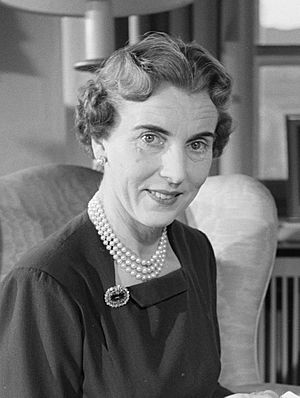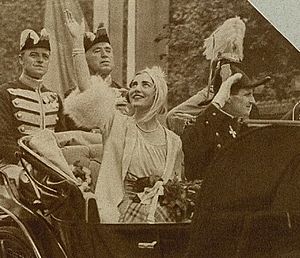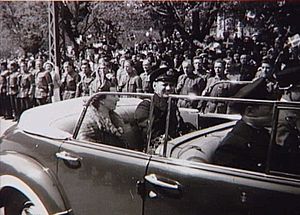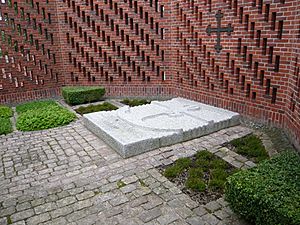Ingrid of Sweden facts for kids
Quick facts for kids Ingrid of Sweden |
|||||
|---|---|---|---|---|---|

Ingrid in 1954
|
|||||
| Queen consort of Denmark | |||||
| Tenure | 20 April 1947 – 14 January 1972 | ||||
| Born | 28 March 1910 Stockholm Palace, Stockholm, Sweden |
||||
| Died | 7 November 2000 (aged 90) Fredensborg Palace, Fredensborg, Denmark |
||||
| Burial | 14 November 2000 Roskilde Cathedral, Roskilde, Denmark |
||||
| Spouse | |||||
| Issue |
|
||||
|
|||||
| House | Bernadotte | ||||
| Father | Gustaf VI Adolf of Sweden | ||||
| Mother | Margaret of Connaught | ||||
Ingrid of Sweden (born Princess Ingrid Victoria Sofia Louise Margareta of Sweden; 28 March 1910 – 7 November 2000) was the Queen of Denmark from 1947 to 1972. She was married to King Frederick IX.
Ingrid was born into the House of Bernadotte, which is the royal family of Sweden. Her father was King Gustaf VI Adolf of Sweden, and her mother was Princess Margaret of Connaught. In 1935, she married Crown Prince Frederick of Denmark. They had three daughters: Margrethe, who is now the Queen of Denmark; Benedikte, a Princess of Sayn-Wittgenstein-Berleburg; and Anne-Marie, who was the Queen of the Hellenes.
When her husband became king in 1947, Ingrid became Queen. She changed many old traditions at the Danish court, making official events more relaxed. King Frederick IX passed away in 1972, and their daughter Margrethe became queen. Ingrid was also an aunt to the current Swedish king, King Carl XVI Gustaf.
Contents
Early life
Princess Ingrid was born on 28 March 1910, at the Royal Palace in Stockholm, Sweden. She was the third child and only daughter of Gustaf Adolf, Crown Prince of Sweden, and his first wife, Princess Margaret of Connaught. She was the first royal princess born into the House of Bernadotte in 80 years.
Ingrid was named Ingrid Victoria Sofia Louise Margareta. She was baptized on 5 May 1910. Her godparents included many important royal figures from Europe.
Ingrid and her family lived in apartments at the Royal Palace in Stockholm. They also had a mansion near the capital and a summer home called Sofiero Palace in southern Sweden. Ingrid's mother started a school for her and a few other Swedish noble girls. Ingrid also learned important household skills like cooking and washing dishes. At that time, it was seen as important for royal girls to know how to manage a home.
In 1920, when Ingrid was only ten years old, her mother sadly passed away. After this, Ingrid spent several months each year in the United Kingdom with her grandfather. People believed that her mother's death made Ingrid very self-disciplined. Three years later, her father married Lady Louise Mountbatten. Ingrid felt upset by her father's remarriage at first, but they later became close again.
Ingrid studied history, art history, political science, and several languages. She learned a lot about art and culture during long trips to Paris and Rome. In 1934-1935, she traveled through the Middle East with her father, stepmother, and brother. Ingrid loved sports, especially horse-riding, skiing, and tennis. She was known for being stylish and attractive. She often played tennis with her grandfather, King Gustav V. As a young adult, Ingrid was often seen driving her car around Stockholm.
Marriage

People often talked about who Ingrid would marry in the 1920s. She was considered a possible wife for different foreign royals, including the Prince of Wales from Britain.
On 15 March 1935, just before her 25th birthday, she became engaged to Frederick, Crown Prince of Denmark and Iceland. They were related in several ways, being cousins through different royal lines. They were married in Stockholm Cathedral on 24 May 1935. Many important guests attended the wedding, including kings, queens, and crown princes from other countries. Her wedding was a huge media event in Sweden in 1935. Ingrid even spoke on the radio, reading a poem, which was also a big deal at the time.
Crown Princess

As Crown Princess, Ingrid became the official patron of the Girl Guides in 1936. She even passed the same tests that all applicants had to take. In 1940, before the occupation, she led the Danish Women's war-effort society.
During the German occupation of Denmark in World War II, Ingrid showed great courage. She influenced the Danish Royal House and how they acted towards the occupation forces. She became very popular as a symbol of quiet resistance and national pride. She often rode her bicycle or pushed her baby carriage through the streets of Copenhagen, showing her support for the Danish people.
Her open defiance worried her grandfather, King Gustav of Sweden. In 1941, he asked her to be more careful for the safety of the royal family. But Ingrid was angry and refused, and her husband supported her. One way Ingrid showed her defiance was by placing the flags of Denmark, Sweden, and the United Kingdom in the window of her children's room at Amalienborg, the royal residence.
Queen consort
When her husband became king on 20 April 1947, Ingrid became the Queen of Denmark. As Queen, she changed many old traditions at the Danish court. She got rid of old-fashioned customs and made official receptions more relaxed and welcoming. She loved gardening and art. She also renovated Gråsten Palace based on her own historical research about how the palace originally looked.
Queen mother
In 1972, King Frederick IX passed away, and Ingrid became a widow at 61. Her oldest daughter, Margrethe, became the new queen. Ingrid then took on the role of the family's leader. That same year, after promising to respect the Danish constitution, she was appointed Rigsforstander. This meant she could act as regent (a temporary ruler) whenever her daughter (and later her grandsons) were away. This was special because, since 1871, only the Crown Prince had been allowed to be regent.
She was a patron of many social organizations, slowly passing these roles to Princess Benedikte as she got older. She was known for being dedicated, well-prepared, and full of energy.
Death
Queen Ingrid passed away on 7 November 2000, at Fredensborg Palace. Her three daughters—Queen Margrethe II, Princess Benedikte, and Queen Anne-Marie of Greece—and ten grandchildren were with her. Thousands of people gathered outside Amalienborg Palace, her home, after her death was announced. They left flowers, lit candles, and sang hymns to honor her.
Her funeral was held on 14 November 2000. Ingrid was buried next to her husband, King Frederick IX, outside Roskilde Cathedral near Copenhagen. Many kings, queens, and heads of state from Europe attended the funeral.
Issue
Queen Ingrid and King Frederick IX had three daughters, ten grandchildren, and twenty-one great-grandchildren.
- Margrethe II of Denmark (born 16 April 1940) married Henri de Laborde de Monpezat on 10 June 1967. They have two sons and eight grandchildren.
- Princess Benedikte of Denmark (born 29 April 1944) married Prince Richard of Sayn-Wittgenstein-Berleburg on 3 February 1968. They have three children and four grandchildren.
- Queen Anne-Marie of Greece (born 30 August 1946) married King Constantine II of Greece on 18 September 1964. They have five children and nine grandchildren.
Images for kids
-
Queen Ingrid's Arms as displayed in the Frederiksborg Castle in Hillerød.
See also
 In Spanish: Ingrid de Suecia para niños
In Spanish: Ingrid de Suecia para niños









